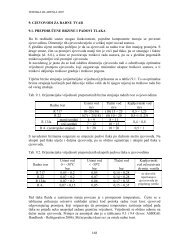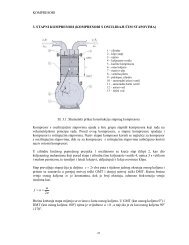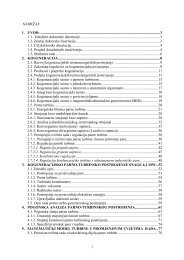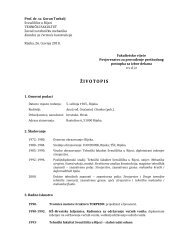universityâenterprise cooperation
universityâenterprise cooperation
universityâenterprise cooperation
Create successful ePaper yourself
Turn your PDF publications into a flip-book with our unique Google optimized e-Paper software.
116<br />
Recommendation 3<br />
Establishment of the Science and Technology<br />
Parks should be encouraged with activities to<br />
promote networking between their tenants.<br />
Recommendation 4<br />
Industrial clusters should be encouraged to move<br />
to internationalization so that they develop an<br />
outward exporting orientation and link up with<br />
international systems of innovation.<br />
Recommendation 5<br />
Universities should boost their incubation<br />
centers to provide more support to researchers<br />
to commercialize their application oriented<br />
research results though the creation of new<br />
spin-off enterprises.<br />
Recommendation 6<br />
Universities in WBC region should establish<br />
Technology Transfer Centers to handle property<br />
rights issues and the licensing of inventions<br />
and innovations created in university<br />
laboratories and to encourage patenting and<br />
licensing of technologies to enterprises.<br />
Recommendation 7<br />
Universities should focus on applied research<br />
activities. A record of collaboration with<br />
enterprises and participation in joint research<br />
projects should be included in academic staff<br />
promotion criteria.<br />
6.4 Future steps<br />
To improve WBC’s innovative capacity in<br />
particular, more resources for science and R&D will<br />
not be enough. The focus needs to shift to:<br />
• The microeconomic capacity of WB region;<br />
• Quality and specialization of factor<br />
conditions;<br />
• Sophistication of demand;<br />
• Quality of enterprise strategies and<br />
entrepreneurship;<br />
• Presence and depth of clusters.<br />
These are the qualities of the business<br />
environment that enable the transformation<br />
of scientific knowledge into new products,<br />
services and competitive firms.<br />
Universities in the WBCs should be important<br />
elements of their local systems of innovation:<br />
• Driver of regional technology-based<br />
development and the source of a major<br />
proportion of local innovations and<br />
local companies;<br />
• A good contributor to local knowledge and to<br />
the development of local technology clusters;<br />
• A major source of knowledge in emerging<br />
and established clusters.<br />
As an important future step need to be<br />
involvement of proposed WBC model<br />
of university-enterprise <strong>cooperation</strong> in<br />
corresponding strategic documents such<br />
as Regional Development Plans or Scientific<br />
and Technological development Strategies<br />
or university memoranda, etc. Innovation<br />
policy should be seen as the cumulative<br />
result of interaction among governments at<br />
various levels, businesspersons, academics,<br />
and social partners comprising membership<br />
from all of these spheres, especially at the<br />
regional level.<br />
Furthermore, it is necessary to establish new<br />
institutional arrangements of university–<br />
enterprise–government relations. Next step<br />
will be generating a knowledge infrastructure<br />
in terms of overlapping institutional spheres<br />
with hybrid organizations emerging at the<br />
interfaces as can be seen in Figure 5.<br />
In order to realize full capacities of knowledge<br />
triangle in the near future, WBCs should attain<br />
some form of model presented in Figure 5, known<br />
as a triple helix model. The common objective is<br />
to realize an innovative environment consisting<br />
of university spin-off firms, tri-lateral initiatives<br />
for knowledge-based economic development, and<br />
strategic alliances among firms (large and small,<br />
operating in different areas, and with different<br />
levels of technology), government laboratories,<br />
and academic research groups.
















